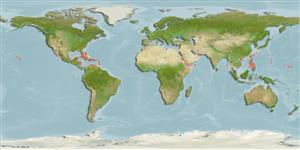Common names from other countries
Environment: milieu / climate zone / depth range / distribution range
Οικολογία
; Γλυκού νερού; εύρος βάθους 0 - 1 m (Ref. 83435). Tropical; 32°N - 9°N, 90°E - 60°E (Ref. 83435)
Indo-Pacific and Western Central Atlantic.
Length at first maturity / Μέγεθος / Βάρος / Age
Maturity: Lm ? range ? - ? cm Max length : 3.5 cm SHL αρσενικό/απροσδιόριστο; (Ref. 349); common length : 2.5 cm SHL αρσενικό/απροσδιόριστο; (Ref. 349)
Used as food by coastal populations of oceanic islands in the West Pacific (Ref. 349). Very common in the upper part of shores, often in crevices and pits of rock benches, or on branches of littoral trees overhanging the water. Moves up and down the shore in correlation with the prevailing high water level of the tide and can withstand heat and desiccation for long periods (Ref. 349). Nocturnal. Grazes on surface film of very fine marl particles, detritus, algae, flagellates, diatoms and nematodes (Ref. 96894).
Life cycle and mating behavior
Γεννητική Ωρίμανση | Αναπαραγωγή | Γεννοβολία | Αβγά | Γονιμότητα | Προνύμφες
Members of the order Neritopsina are mostly gonochoric and broadcast spawners. Life cycle: Embryos develop into planktonic trocophore larvae and later into juvenile veligers before becoming fully grown adults.
Poutiers, J.M. 1998. (Ref. 349)
IUCN Red List Status (Ref. 130435)
CITES status (Ref. 108899)
Not Evaluated
Not Evaluated
Human uses
αλιεία: Εμπορικό(ά)
| FishSource | Η θάλασσα γύρω μας
Εργαλεία
Περισσότερες πληροφορίες
Age/SizeΑύξησηLength-weightLength-lengthΜορφολογίαΠρονύμφεςΑφθονία
Διαδικτυακές πηγές
Estimates based on models
Preferred temperature
(Ref.
115969): 25.2 - 28.9, mean 27.7 (based on 945 cells).
Vulnerability
Low vulnerability (10 of 100).
Price category
Unknown.
